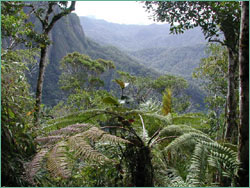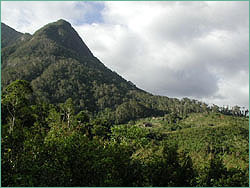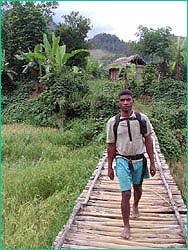
|
 |
 June 7, 2000 Forest of Hope Without the forest, there will be no more water,Two days ago, while the rest of the team left the forest to attend the National Day of the Environment in nearby Andapa, I stayed behind at Camp Two. After five days lost to a blazing foot infection, and two more days of delicate hobbling around, I needed a final day to do at least some cursory exploring of this extraordinary forest.
Our destination was a narrow opening on a razorback ridge high above Camp Two. It was called Mandrivotra ("nice wind"). It would be a long, steep climb up a slippery trail, but it afforded one of the few views out over the forests of Marojejy. On Monday it had rained all day, making a miserable, leech-rich hike out for the team. But Tuesday felt drier, and by the time we reached Mandrivotra after a strenuous 90-minute slog, the sun was scooting in and out of fleecy clouds. The view was magnificent. On both sides of the steeply pitched ridge, mountains feathered in pure, primary rain forest stepped back as far as the eye could see. All save in the direction of the road from which we'd trekked in, that is. There, off in the blue distance, I could just make out bare slopes where local Malagasy had cleared hillsides to plant rice.
What rural Malagasy need is alternatives to shifting agriculture, and one of the most promising is ecotourism. Now that Marojejy is a national park, half of all visitor entrance fees will go to local villages (the other half goes to the national parks authority). People like Desiré Rabary and Nestor Randrianasy can make good money guiding and cooking and providing other services for visitors. But even a successful national park like Ranomafana, a rainforest park in the southeast, gets only about 10,000 visitors a year, and there will always be only so much work to go around. The challenge in such situations - and it's a monstrous one - is to find ways to ensure that as broad a swath of the local population benefits from the park as possible. After a lunch of rice and beans, forked down while rain fell in great sheets just beyond the edge of the cook tent's overhanging tarp, we headed down out of the park. Along the way, we encountered more of the park's natural wonders: a paradise flycatcher with its impossibly long tail feathers; two troops of eastern gray bamboo lemurs eyeing us silently before crashing off through the trees; a black, squiggly fungus aptly called "dead man's finger"; innumerable tiny waterfalls spilling out of the heights.
Rabary understands this implicitly. He was telling anyone who would listen - including Pat Wright, who did listen—about the urgent need to protect a corridor of rain forest that stretches from Marojejy to Masoala. Formed in 1997, Masoala is another national park that protects the largest remaining stand of primary rain forest on the island. Unless this corridor gains protection, he fears it will be gone within just three years. Such conservation-mindedness is sorely needed in Madagascar—along with continued and increased conservation and development funding from the West. One can only hope that protected areas like the Ankarana Reserve and the new Marojejy National Park, along with the benefits that can accrue from them, foster such thinking on a broader scale than currently exists. Hope springs eternal, especially with people like Desiré Rabary around. Peter Tyson is Online Producer of NOVA. Dispatches Forest of Hope (June 7, 2000) A Great Day for Silkies (June 4, 2000) Camp Life Unveiled (June 3, 2000) Three Hours with the Silkies (June 1, 2000) Angels of Marojejy (May 31, 2000) Wildlife (May 30, 2000) Into the Marojejy Massif (May 28, 2000) Croc Cave (May 26, 2000) Fossa! (May 25, 2000) Bat Cave (May 24, 2000) Update: English Camp (May 23, 2000) Update: Sunken Forest (May 21, 2000) Update: Night Walk (May 20, 2000) Update: 70 Feet Up (May 19, 2000) Update: Tropical Downpour (May 18, 2000) Photos: Peter Tyson. The Expedition | Surviving The Wilds | Explore Madagascar Dispatches | Classroom Resources | E-Mail | Resources Site Map | The Wilds of Madagascar Home Editor's Picks | Previous Sites | Join Us/E-mail | TV/Web Schedule About NOVA | Teachers | Site Map | Shop | Jobs | Search | To print PBS Online | NOVA Online | WGBH © | Updated November 2000 |
 The view from just below the razorback ridge, high
above Camp Two at Marojejy.
The view from just below the razorback ridge, high
above Camp Two at Marojejy.
 The edge of Marojejy National Park, where primary
forest meets secondary forest and farm fields, is
clearly defined.
The edge of Marojejy National Park, where primary
forest meets secondary forest and farm fields, is
clearly defined.
 Bevo Rajaonina, a brawny young porter, makes his way
through the pastiche of rice fields, small hamlets,
and secondary forest just outside Marojejy National
Park.
Bevo Rajaonina, a brawny young porter, makes his way
through the pastiche of rice fields, small hamlets,
and secondary forest just outside Marojejy National
Park.